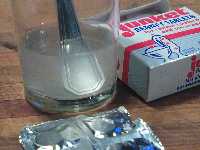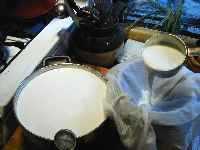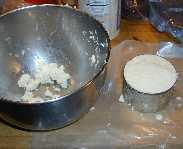This soft unripened rennet cheese is originally from the town of Neufchâtel in the region of Normandy, but is made extensively throughout France. It is reported in the Encyclopedia Britannica to be the same as Bondon, Malakoff, Petit Carre, and Petit Suisse, depending on the shape into which it is molded (square, rectangular, cylindrical and the special heart-shape variety called Coeur de Bray.) It is easy to make, and may be used like cream cheese.
A version common in the United States is so-called Farmer’s Cheese.
Being easy to make, it is the most common style of goat cheese to be found in the American marketplace. For that reason, many people only think of it when they hear “goat cheese.” It should be used fresh, as it may develop an off flavor after storage of several weeks. Similar to cream cheese, and a less tart version of labneh, a yogurt cheese of the Middle East, its mild flavor makes it ideal for use where the flavor of other ingredients are to be emphasized. Indeed, many home cheese makers like to add herbs or seasonings to their neufchâtel to personalize their own cheese. I still prefer the pure unadulterated version which can be seasoned just prior to serving.
Recipe for 1.5 pounds of Neufchatel
Equipment
- 5 quart stainless steel pot with lid (sterilized by boiling water in it for 5 minutes prior to use)
- thermometer reading in the 50-100°F range
- sterile clean handkerchief
- large strainer or colander
Ingredients
- 1 gallon fresh whole milk (store-bought may be used)
(Use skimmed milk for low fat but less flavorful cheese) - 1/4 cup cultured buttermilk
(or 2 ice cubes of frozen buttermilk) - 1/4 tablet Rennet
Directions
 1. Assemble ingredients: fresh milk, buttermilk (in this case, frozen cubes of buttermilk, but fresh cultured buttermilk works perfectly). The pot has been sterilized by covering and boiling a small amount of water for five minutes.
1. Assemble ingredients: fresh milk, buttermilk (in this case, frozen cubes of buttermilk, but fresh cultured buttermilk works perfectly). The pot has been sterilized by covering and boiling a small amount of water for five minutes.
I am using my fresh goat’s milk, but store-bought whole, partially skimmed or skimmed will work. The less cream, the less rich and full bodied flavor you get.
 2. Add buttermilk to milk in a pre-sterilized 5 quart stainless steel pot. Here I add two “ice cubes” of frozen buttermilk, but 1/4th cup fresh cultured buttermilk works very well. If using ice cubed starter, stir until completely melted.
2. Add buttermilk to milk in a pre-sterilized 5 quart stainless steel pot. Here I add two “ice cubes” of frozen buttermilk, but 1/4th cup fresh cultured buttermilk works very well. If using ice cubed starter, stir until completely melted.
Warm with stirring to a final temperature of 65°F.
 3. Meanwhile, dissolve 1/4 tablet rennet in 1/4 cup cool water. (If you use liquid rennet, use four drops/gallon. Be sure it is not outdated.)
3. Meanwhile, dissolve 1/4 tablet rennet in 1/4 cup cool water. (If you use liquid rennet, use four drops/gallon. Be sure it is not outdated.)
 4. The rennet is now dissolved. Note that it will be slightly turbid, but there are no remaining pieces on the bottom of the glass.
4. The rennet is now dissolved. Note that it will be slightly turbid, but there are no remaining pieces on the bottom of the glass.
 5. Add the dissolved rennet into the 65°F inoculated milk with stirring.
5. Add the dissolved rennet into the 65°F inoculated milk with stirring.
 6. Stir well to blend thoroughly.
6. Stir well to blend thoroughly.
 7. Cover and let sit undisturbed overnight at room temperature (65-70°F,
7. Cover and let sit undisturbed overnight at room temperature (65-70°F,
20°C).
 8. The next AM, a soft curd should have formed. (If not, let sit until it does form. In the illustration, the curd was NOT adequately formed, and I let it sit for another 12 hours… Here is a page on troubleshooting failure to get a clean break )
8. The next AM, a soft curd should have formed. (If not, let sit until it does form. In the illustration, the curd was NOT adequately formed, and I let it sit for another 12 hours… Here is a page on troubleshooting failure to get a clean break )
When curd is adequately formed, cut it into ½ inch cubes. [Here is a picture of curds being cut .] Some recipes call for stirring the soft curd instead of cutting. I suspect this would make the separation of curds and whey more difficult. Ladle cut curds into a clean sterile handkerchief suspended in large strainer or stainless steel colander. Pour the remaining whey through the cloth. If the cloth becomes clogged, lift the cloth back and forth or scrape the forming cheese away from the cloth.
 9. Hang the curd in a cool place to allow the whey to drip out: pick up the four corners of the cloth, wrap a heavy rubberband around, and loop one end through the other end. Insert a chopstick through the open end, and suspend the cheese bag over a receiving vessel to catch the whey. Here, I have hung the cloth in our “milk” refrigerator. Let hang over night.
9. Hang the curd in a cool place to allow the whey to drip out: pick up the four corners of the cloth, wrap a heavy rubberband around, and loop one end through the other end. Insert a chopstick through the open end, and suspend the cheese bag over a receiving vessel to catch the whey. Here, I have hung the cloth in our “milk” refrigerator. Let hang over night.
 10. The next day, open the cloth to reveal the cheese.
10. The next day, open the cloth to reveal the cheese.
 11. This is what the cheese looks like turned over.
11. This is what the cheese looks like turned over.
 12. Sprinkle on 1- 2 teaspoons of salt, according to taste. Inadequately salted cheese will be more bland, and will not keep as well. Work to mix the salt in thoroughly. Store covered in the refrigerator until use. Recycled cottage cheese containers work well for this.
12. Sprinkle on 1- 2 teaspoons of salt, according to taste. Inadequately salted cheese will be more bland, and will not keep as well. Work to mix the salt in thoroughly. Store covered in the refrigerator until use. Recycled cottage cheese containers work well for this.
 13. If you like, you may pack the cheese into a mold of your choice (a squat tin can with the ends removed, in this case).
13. If you like, you may pack the cheese into a mold of your choice (a squat tin can with the ends removed, in this case).
 14. Here the cheese has been removed from the tin can mold, showing its “molded look.”
14. Here the cheese has been removed from the tin can mold, showing its “molded look.”
 15. Here is the unmolded cheese displayed on a decorative plate.
15. Here is the unmolded cheese displayed on a decorative plate.
